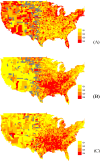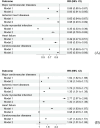The role of environmental access to exercise opportunities in cardiovascular mortality: evidence from a nationwide study
- PMID: 40251637
- PMCID: PMC12008913
- DOI: 10.1186/s12916-025-04060-8
The role of environmental access to exercise opportunities in cardiovascular mortality: evidence from a nationwide study
Abstract
Background: Environmental access to exercise opportunities plays a crucial role in determining the level of physical activity within a population. However, it is unclear how environmental factors contribute to disparities in physical activity and health outcomes. We explored the associations between county-level access to exercise opportunities and cardiovascular disease (CVD) mortality across US counties.
Methods: We conducted an ecological analysis using aggregated data from two primary sources: the County Health Rankings and Roadmaps data and CDC WONDER mortality data. We compared county-level age-adjusted CVD mortality across county-level quartiles of access to exercise opportunities and physical inactivity. Stratification was performed based on age, sex, race, and urbanization variables. The rate ratio (RR) for CVD mortality was also calculated using generalized linear models.
Results: We observed significant variations in CVD mortality across different levels of exercise opportunities access and physical inactivity, which was consistent across all demographic subgroups (P < 0.001). Access to exercise opportunities was significantly associated with a reduced risk of CVD mortality (RR = 0.93 [0.91-0.95]), and the association was most pronounced for acute myocardial infarction (AMI) mortality (RR, 0.80 [0.76-0.85]). The county-level physical inactivity was significantly associated with an increased risk of CVD mortality (RR, 1.16 [1.14-1.17]), especially for ischemic heart disease (IHD) (RR, 1.35 [1.31-1.38]) and AMI (RR, 1.32 [1.25-1.38]). All demographic subgroups demonstrated similar benefits in reducing the risk of CVD by improving the county-level indicators of physical activity.
Conclusions: Counties have the potential to make significant environmental strides in improving the cardiovascular health of their populations by enhancing access to exercise opportunities in the context of urbanization.
Keywords: Access to exercise opportunities; Cardiovascular disease; Nationwide study; Physical inactivity.
© 2025. The Author(s).
Conflict of interest statement
Declarations. Ethics approval and consent to participate: Not applicable. Consent for publication: The authors declare no competing interests. Competing interests: The authors declare no competing interests.
Figures


Similar articles
-
Social Vulnerability and Premature Cardiovascular Mortality Among US Counties, 2014 to 2018.Circulation. 2021 Oct 19;144(16):1272-1279. doi: 10.1161/CIRCULATIONAHA.121.054516. Epub 2021 Oct 18. Circulation. 2021. PMID: 34662161
-
Association of access to exercise opportunities and cardiovascular mortality.Am Heart J. 2019 Jun;212:152-156. doi: 10.1016/j.ahj.2019.02.010. Epub 2019 Mar 7. Am Heart J. 2019. PMID: 31051426
-
Association between racial residential segregation and Black-White disparities in cardiovascular disease mortality.Am Heart J. 2023 Oct;264:143-152. doi: 10.1016/j.ahj.2023.06.010. Epub 2023 Jun 24. Am Heart J. 2023. PMID: 37364747 Free PMC article.
-
Statin Use for the Primary Prevention of Cardiovascular Disease in Adults: Updated Evidence Report and Systematic Review for the US Preventive Services Task Force.JAMA. 2022 Aug 23;328(8):754-771. doi: 10.1001/jama.2022.12138. JAMA. 2022. PMID: 35997724
-
Dose-Response Relationship Between Physical Activity and the Morbidity and Mortality of Cardiovascular Disease Among Individuals With Diabetes: Meta-Analysis of Prospective Cohort Studies.JMIR Public Health Surveill. 2024 Aug 19;10:e54318. doi: 10.2196/54318. JMIR Public Health Surveill. 2024. PMID: 38780218 Free PMC article.
References
-
- Virani SS, Alonso A, Aparicio HJ, Benjamin EJ, Bittencourt MS, Callaway CW, Carson AP, Chamberlain AM, Cheng S, Delling FN, et al. Heart disease and stroke statistics—2021 update. Circulation. 2021;143(8):e254–743. - PubMed
-
- Aerts N, Le Goff D, Odorico M, Le Reste JY, Van Bogaert P, Peremans L, Musinguzi G, Van Royen P, Bastiaens H. Systematic review of international clinical guidelines for the promotion of physical activity for the primary prevention of cardiovascular diseases. BMC Fam Pract. 2021;22(1):97. - PMC - PubMed
-
- Isath A, Koziol KJ, Martinez MW, Garber CE, Martinez MN, Emery MS, Baggish AL, Naidu SS, Lavie CJ, Arena R, et al. Exercise and cardiovascular health: a state-of-the-art review. Prog Cardiovasc Dis. 2023;79:44–52. - PubMed
MeSH terms
Grants and funding
LinkOut - more resources
Full Text Sources
Medical

